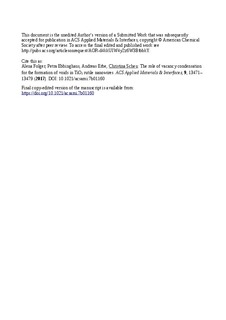The role of vacancy condensation for the formation of voids in rutile TiO2 nanowires
Journal article, Peer reviewed
Permanent lenke
http://hdl.handle.net/11250/2443791Utgivelsesdato
2017Metadata
Vis full innførselSamlinger
- Institutt for materialteknologi [2545]
- Publikasjoner fra CRIStin - NTNU [38069]
Sammendrag
Titanium dioxide nanowire (NW) arrays are incorporated in many devices for energy conversion, energy storage, and catalysis. A common approach to fabricate these NWs is based on hydrothermal synthesis strategies. A drawback of this low-temperature method is that the NWs have a high density of defects, such as stacking faults, dislocations, and oxygen vacancies. These defects compromise the performance of devices. Here, we report a postgrowth thermal annealing procedure to remove these lattice defects and propose a mechanism to explain the underlying changes in the structure of the NWs. A detailed transmission electron microscopy study including in situ observation at elevated temperatures reveals a two-stage process. Additional spectroscopic analyses and X-ray diffraction experiments clarify the underlying mechanisms. In an early, low-temperature stage, the as-grown mesocrystalline NW converts to a single crystal by the dehydration of surface-bound OH groups. At temperatures above 500 °C, condensation of oxygen vacancies takes place, which leads to the fabrication of NWs with internal voids. These voids are faceted and covered with Ti3+-rich amorphous TiOx.
